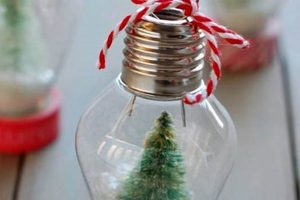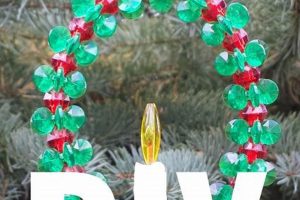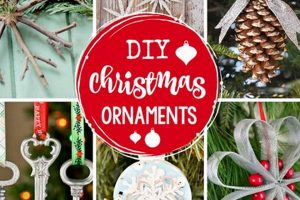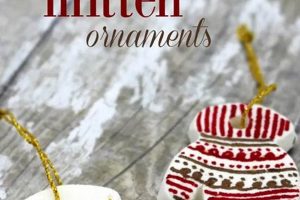The construction of miniature, self-contained winter scenes within a transparent sphere suitable for holiday adornment represents a popular crafting activity. These miniature displays, often incorporating figures, glitter, and a liquid medium, are designed to mimic a snow-filled environment when shaken. A finished example is frequently hung on a Christmas tree or displayed as a festive decoration.
Creating personalized holiday decorations offers several advantages, including cost savings, customization, and the opportunity for engaging in a creative activity. The development of such personalized items allows for the incorporation of unique themes and materials, reflecting individual preferences. Furthermore, the practice provides a tangible connection to the holiday season and can foster a sense of accomplishment.
The subsequent sections will detail the materials required for constructing these decorative pieces, outline a step-by-step assembly process, and offer guidance on customizing the design for a unique final product. These instructions and tips will ensure a satisfying crafting experience.
Construction Optimization Guide
The following recommendations are designed to maximize the quality and longevity of constructed miniature snow scenes intended for seasonal ornamentation.
Tip 1: Selection of Sealing Agents: Employ waterproof adhesives specifically formulated for use with glass and plastics. Inadequate sealant selection can result in clouding of the water or structural failure.
Tip 2: Fluid Medium Composition: Distilled water is preferable as a base. The addition of glycerin retards glitter settling, enhancing the visual effect. Avoid tap water due to mineral content.
Tip 3: Securing Interior Components: Ensure internal figures and decorative elements are securely affixed to the base. Movement can compromise the visual aesthetic and lead to damage during handling.
Tip 4: Glitter Particle Size and Type: Finely milled glitter provides a more realistic snow effect. Opt for polyester glitter to prevent color bleeding or degradation in the liquid medium.
Tip 5: Container Inspection and Preparation: Prior to assembly, thoroughly inspect the chosen container for cracks or imperfections. Clean the interior surfaces with a non-abrasive cleaner to promote adhesion.
Tip 6: Adequate Curing Time: Allow sufficient curing time for all adhesives before introducing the liquid medium. Premature introduction of liquid can weaken bonds and cause leaks.
Tip 7: Avoiding Overfilling: Leave a small air gap at the top of the container. Fluctuations in temperature can cause expansion and contraction of the liquid, potentially compromising the seal if overfilled.
Following these directives will result in a robust and visually appealing decorative piece capable of withstanding extended display periods. Adherence to material compatibility guidelines is paramount.
The subsequent conclusion will recap key construction elements and provide suggestions for long-term maintenance, ensuring prolonged ornamental integrity.
1. Material Selection
Material selection is a foundational element in the successful creation and preservation of do-it-yourself snow globe ornaments. The choice of components directly impacts the longevity, clarity, and overall aesthetic of the final product. The selection process requires careful consideration of compatibility, durability, and resistance to degradation within the liquid environment.
- Container Composition
The container, typically glass or durable plastic, dictates the visual clarity and structural integrity of the snow globe. Glass offers superior clarity and scratch resistance, while plastic provides enhanced impact resistance, reducing the risk of breakage. The chosen material must be non-reactive to the liquid medium and capable of withstanding prolonged immersion.
- Adhesive Properties
The adhesive agent employed for securing internal components must exhibit exceptional waterproof qualities and maintain bond strength when submerged in water. Epoxies and specialized silicone adhesives are often favored for their resistance to degradation and their ability to create a durable, watertight seal. Improper adhesive selection can lead to component detachment and clouding of the water.
- Figurine Material
The figurines placed within the snow globe must be crafted from materials that are non-toxic, waterproof, and resistant to fading or discoloration. Polymers, ceramics, and certain types of treated wood are commonly used. Painted surfaces require a protective sealant to prevent leaching of color into the water, which can compromise the aesthetic appeal.
- Liquid Medium Additives
The liquid medium, generally a combination of distilled water and glycerin, necessitates high purity. Distilled water minimizes mineral deposits and clouding, while glycerin increases viscosity, slowing the descent of glitter and creating a more prolonged snow effect. Improperly sourced or contaminated additives can detrimentally affect clarity and promote bacterial growth.
The interplay between these material choices directly influences the quality and longevity of the handcrafted ornament. Prioritizing material compatibility and resistance to degradation is paramount to ensuring the creation of a visually appealing and durable holiday decoration. Subsequent assembly and handling contribute to the final outcome.
2. Sealing Integrity
Maintaining a hermetic seal is paramount in the construction of miniature snow scenes intended for ornamental display. The effectiveness of this seal directly influences the longevity, clarity, and overall aesthetic appeal of the finished product, rendering it a critical consideration in the crafting process.
- Adhesive Selection and Application
The selection of an appropriate adhesive, specifically formulated for bonding dissimilar materials such as glass, plastic, and metal, is crucial. Proper application techniques, including surface preparation and uniform adhesive distribution, ensure a robust and leak-proof bond. Insufficient adhesive strength or improper application can result in seal failure, leading to water leakage and subsequent damage to the internal components.
- Container Closure Mechanism
The method of closure, whether involving a threaded cap, a press-fit stopper, or a permanently sealed base, directly impacts the long-term integrity of the enclosure. Threaded caps require the use of appropriate sealing gaskets to prevent leakage under pressure or temperature fluctuations. Press-fit stoppers necessitate precise dimensional tolerances to ensure a secure and watertight fit. Permanent sealing methods require specialized equipment and techniques to create an impermeable barrier.
- Material Compatibility and Chemical Resistance
The chemical compatibility of the sealing materials with the liquid medium within the snow scene is essential. Certain adhesives and gaskets may degrade or dissolve in the presence of water, glycerin, or other additives, compromising the seal and potentially contaminating the liquid. Selecting materials that are resistant to chemical degradation ensures the prolonged integrity of the enclosure and the clarity of the internal environment.
- Environmental Stressors and Mitigation
The finished snow scene ornament is susceptible to environmental stressors such as temperature fluctuations, humidity variations, and physical impact. These stressors can induce stress cracks, weaken adhesive bonds, and compromise the integrity of the seal. Implementing preventative measures, such as storing the ornament in a stable environment and protecting it from physical trauma, can mitigate these risks and extend its lifespan.
The interplay of these factors underscores the significance of meticulous attention to sealing integrity in the construction of decorative snow globes. Addressing each element with precision and foresight ensures the creation of a visually appealing and enduring ornamental piece capable of withstanding the rigors of long-term display and storage.
3. Liquid Clarity
The visual appeal of miniature winter scenes for seasonal adornment is critically dependent on the clarity of the liquid medium employed within the sphere. Degradation in liquid clarity detracts from the intended aesthetic, rendering the scene opaque and obscuring internal elements. Therefore, achieving and maintaining optimal liquid clarity is paramount for a successful outcome.
- Water Purity and Source
The selection of water source directly impacts clarity. Distilled water is recommended due to its minimal mineral content, reducing the likelihood of clouding or sediment formation over time. Tap water, conversely, contains dissolved minerals that can precipitate out of solution, leading to a gradual decrease in visibility. The use of deionized water provides a further refinement, removing virtually all ionic contaminants.
- Additive Selection and Compatibility
Additives, such as glycerin, are often incorporated to increase viscosity and slow the descent of particulate matter, simulating a more realistic snowfall effect. However, the chosen additives must be chemically compatible with the water and the other internal components. Incompatible additives can cause reactions that result in clouding, discoloration, or the formation of precipitates. Careful consideration must be given to the purity and stability of any added substances.
- Seal Integrity and Prevention of Contamination
Maintaining a hermetic seal is crucial to prevent the ingress of contaminants from the external environment. Leaks can allow bacteria, fungi, or other microorganisms to enter the liquid medium, leading to biological growth and a corresponding reduction in clarity. Proper sealing techniques and the use of appropriate adhesives are essential to ensuring a long-lasting, contamination-free environment.
- Material Inertness and Leaching
The materials used for the internal components of the snow globe, such as figurines and decorative elements, must be inert and resistant to leaching. Some materials can release dyes, pigments, or other substances into the liquid medium, causing discoloration or turbidity. Selecting materials that are specifically designed for aqueous environments and that have been tested for leachability is critical for preserving liquid clarity over time.
The discussed aspects collectively influence the visual integrity of crafted miniature winter scenes. Attentive material selection and meticulous sealing processes are necessary to uphold optimal visual quality for prolonged periods. Deviation from recommended practices can compromise the visual appeal and reduce the lifespan of these decorative items.
4. Figure Stability
Within the realm of handcrafted decorative snow globes, figure stability represents a critical factor governing the overall quality and longevity of the finished product. Unstable figures detract from the aesthetic appeal and, in severe cases, can compromise the structural integrity of the entire ornament. The secure and permanent affixation of internal figures directly impacts the visual harmony and the perceived value of the decorative piece. For example, poorly adhered figures can detach, float freely within the liquid medium, or collide with the container walls, resulting in chipping or breakage.
The implementation of appropriate adhesives and bonding techniques is essential for ensuring figure stability. Selection of a waterproof, non-reactive adhesive compatible with the figurine material and the base is crucial. The adhesive application process must be meticulous, ensuring complete coverage of the bonding surfaces and adequate curing time. As a practical example, consider the use of two-part epoxy resins, known for their high bond strength and resistance to degradation in aqueous environments. Furthermore, the weight distribution and center of gravity of the figure should be considered to minimize stress on the adhesive bond. Larger or more complex figures may require additional support structures or bracing to maintain stability.
In summary, figure stability is not merely a cosmetic concern but an integral aspect of the structural design and long-term viability of handcrafted snow globe ornaments. Achieving optimal figure stability necessitates a careful consideration of material properties, adhesive selection, bonding techniques, and the physical characteristics of the figurines themselves. Neglecting these considerations can lead to premature failure and diminish the overall value of the decorative piece, whereas addressing them thoroughly results in a product demonstrating elevated durability and aesthetic quality.
5. Aesthetic Design
The visual appeal of a handcrafted miniature winter scene intended for holiday ornamentation is significantly influenced by aesthetic considerations. The integration of design principles determines the overall attractiveness and perceived value of the final product.
- Theme Selection and Cohesion
The choice of a unifying theme provides a framework for all subsequent design decisions. Themes can range from traditional winter landscapes to whimsical character scenes. Cohesion is achieved through the consistent application of color palettes, stylistic elements, and narrative details. Disparate elements detract from the visual harmony and diminish the aesthetic impact.
- Composition and Balance
Arranging internal elements within the confined space requires careful attention to composition. Principles of visual balance, such as symmetry or asymmetry, should be applied to create a pleasing arrangement. Overcrowding can result in a cluttered and visually overwhelming scene, while sparse arrangements may appear incomplete. Effective use of foreground, middle ground, and background enhances depth and perspective.
- Color Palette and Harmony
The selection of colors plays a crucial role in establishing the mood and atmosphere of the snow globe. Harmonious color combinations create a sense of visual unity, while contrasting colors can be used to draw attention to specific elements. Consideration should be given to the psychological effects of different colors and their suitability for the chosen theme. For instance, cool blues and whites evoke a sense of winter tranquility, while warm reds and golds convey festive cheer.
- Glitter Selection and Distribution
The type, size, and distribution of glitter significantly impact the perceived snowfall effect. Finely milled glitter creates a more realistic and delicate snowfall, while larger glitter flakes produce a more dramatic and sparkling effect. Uniform distribution of glitter ensures a consistent and visually appealing snowstorm. Clumping or uneven distribution can detract from the overall aesthetic.
In summary, aesthetic design is not merely an additive element but an integral component of crafting visually appealing and engaging miniature winter scenes for ornamental purposes. The thoughtful application of design principles, from theme selection to glitter distribution, elevates the handcrafted piece from a simple craft project to a visually compelling work.
Frequently Asked Questions
The following questions address common inquiries regarding the construction, maintenance, and safety of self-assembled decorative snow globes.
Question 1: What adhesive is most suitable for securing internal components within a snow globe ornament?
Epoxy resins or cyanoacrylate adhesives, specifically formulated for use with the materials in question (glass, plastic, ceramic, etc.), are recommended. Ensure the chosen adhesive is waterproof and non-reactive with the liquid medium to prevent clouding or degradation.
Question 2: What type of liquid should be used to fill a snow globe ornament?
Distilled water is the preferred base. The addition of glycerin or propylene glycol increases the viscosity, slowing the descent of particulate matter and creating a more realistic snowfall effect. Avoid tap water due to mineral content, which can lead to clouding or bacterial growth.
Question 3: How can clouding of the liquid within a snow globe ornament be prevented?
Using distilled water and ensuring all internal components are thoroughly cleaned prior to assembly are essential. Furthermore, selecting materials that are non-reactive with water and resistant to leaching can mitigate the risk of clouding over time.
Question 4: Is there a safe alternative to glass containers for snow globe ornaments intended for use by children?
Durable, shatter-resistant plastics, such as acrylic or polycarbonate, offer a safer alternative to glass. Ensure the chosen plastic is transparent and non-reactive with the liquid medium.
Question 5: How should a snow globe ornament be stored to prevent damage?
Store in a cool, dry location away from direct sunlight to prevent fading or degradation of the internal components. Avoid storing in extreme temperatures, which can cause expansion or contraction of the liquid and potentially compromise the seal.
Question 6: What measures should be taken to prevent bacterial growth within a snow globe ornament?
Thoroughly sterilizing all components prior to assembly and using distilled water are crucial. The addition of a small amount of bleach (approximately 1/8 teaspoon per cup of water) can inhibit bacterial growth. However, exercise caution when using bleach and ensure proper ventilation.
Proper material selection, meticulous assembly techniques, and appropriate storage practices are essential for the creation and preservation of durable and visually appealing snow globe ornaments.
The subsequent conclusion will summarize the key considerations for crafting and maintaining decorative miniature snow scenes.
Conclusion
The preceding analysis has explored the multifaceted considerations inherent in the construction of “diy snowglobe ornament” pieces. Key points encompassed material selection, with emphasis on inertness and compatibility; the imperative of a hermetic seal to prevent leakage and contamination; the significance of liquid clarity for optimal visual presentation; the necessity of stable figure anchoring; and the role of aesthetic design principles in creating a visually compelling miniature scene. Successful execution requires meticulous attention to each of these elements.
Mastery of these techniques facilitates the creation of durable, visually arresting decorative items. Such crafted objects, when properly constructed, transcend mere novelty, embodying a tangible connection to seasonal traditions and individual artistic expression. Continued refinement of construction methods and material exploration promises to further enhance the longevity and artistic merit of self-made miniature winter scenes.







